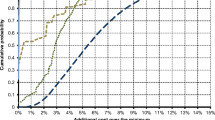Abstract
Small, but fast fluctuating consumptions in a pipe network can lead to severe transient flows. Such fluctuations are stochastic in nature and, cannot be explicitly identified and analyzed for the systems in operation. This study introduces a mathematical model for taking into account the fluctuating consumptions in analysis and design of pipe networks. For this purpose, the fluctuations are simulated by two successive triangular pulses with adjustable geometry. A many-objective optimization problem is developed to find the worst maximum and minimum pressure heads. A new scheme of genetic algorithms is developed to find the extreme values of all pressure heads in only one single simulation run. The proposed model is applied to two water distribution networks. It is found that, the transient flow caused by fast fluctuating consumptions could seriously affect the system’s performance. For instance, analyzing a real pipe network reveals that, when the fluctuations are critically combined, the nodal pressure heads averagely change by 29 % (13 to 88 %) and −43 % (−16 to −177 %) with respect to the initial steady state.








Similar content being viewed by others
Abbreviations
- A :
-
Pipe cross-sectional area
- a :
-
Wave speed
- C :
-
Nodal consumption
- D :
-
Pipe diameter
- f :
-
Darcy-Weisbach friction factor
- g :
-
Gravitational acceleration
- G :
-
Vector of objective functions
- H :
-
Piezometric head
- M :
-
Number of objective functions
- N :
-
Number of network nodes
- L :
-
Pipe length
- Q :
-
Pipe discharge
- R :
-
Rank number
- r :
-
Random real value
- t :
-
Time
- NP :
-
Population size
- N e :
-
Number of elite chromosomes
- NR good :
-
Number of good chromosomes
- \( \overline{R} \) :
-
Averaged rank number
- R good :
-
Threshold rank number for good chromosomes
- T f :
-
Fluctuations simulation time
- t A , t B , t C , t D , t E , t F :
-
Fluctuations time coordinates
- x min, x max, y min, y max :
-
Bounds of decision variables
- ΔC 1 and ΔC 2 :
-
Fluctuations severity heights
- μ :
-
Mutation ratio
- ϕ :
-
Objective function
References
Almeida AB, Koelle E (1992) Fluid transients in pipe networks. Elsevier Applied Science
Boulos PF, Karney BW, Wood DJ, Lingireddy S (2005) Hydraulic transinet guidelines for protecting water distribution systems. J Am Water Resour Assoc 97(5):111–124
Chaudhry MH (1987) Applied hydraulic transients, 2nd edn. Litton Educational/Van Nostrand Reinhold, New York
Duan HF, Tung YK, Ghidaoui MS (2010) Probabilistic analysis of transient design for water supply systems. J Water Resour Plan Manag 136(6):678–687
Ebacher G, Besner MC, Lavoie J, Jung BS, Karney BW, Prévost M (2011) Transient modeling of a full-scale distribution system: comparison with field data. J Water Resour Plan Manag 137(2):173–182
Eshelman LJ, Shaffer DJ (1993) Real-coded genetic algorithms and interval schemata. In: Whitley DL (ed) Foundations of genetic algorithms 2. Morgan Kaufman, San Mateo, pp 187–202
Foster R (2003) Case study of hydraulic transients generated by microfiltration processes. New Pipeline Technologies, Security, and Safety. 877–885
Goldberg DE (1989) Genetic algorithms in search, optimization, and machine learning. Addison-Wesley, Reading
Haghighi A, Keramat A (2012) A fuzzy approach for considering uncertainty in transient analysis of pipe networks. J Hydroinf 14(4):1024–1035
Haghighi A, Ramos H (2012) Detection of leakage freshwater and friction factor calibration in drinking networks using central force optimization. Water Resour Manag 26(8):2347–2363
Haghighi A, Shamloo H (2011) Transient generation in pipe networks for leak detection. Proc Inst Civ Eng Water Manag 164:311–318
Jung BS, Karney BW (2006) Hydraulic optimization of transient protection devices using GA and PSO approaches. J Water Resour Plan Manag 132(1):44–52
Jung BS, Boulos PF, Wood DJ (2009) Effect of pressure sensitive demand on surge analysis. J Am Water Resour Assoc 101(4):100–111
Kapelan ZS, Savic DA, Walters GA (2003) A hybrid inverse transient model for leakage detection and roughness calibration in pipe networks. J Hydraul Res 41(5):481–492
Liggett JA, Chen LC (1994) Inverse transient analysis in pipe networks. J Hydraul Eng 120(8):934–954
Martino GD, Fontana N, Giugni M (2008) J Hydraul Eng 134(9):1395–1399
Pudar RS, Liggett JA (1992) Leaks in pipe networks. J Hydraul Eng 118(7):1031–1046
Ramos H, Tamminen S, Covas D (2009) Water supply system performance for different pipe materials part II: sensitivity analysis to pressure variation. Water Resour Manag 23:367–393
Shamloo H, Haghighi A (2010) Optimum leak detection and calibration of pipe networks by inverse transient analysis. J Hydraul Res 48(3):371–376
Vitkovsky J, Simpson A, Lambert M (2000) Leak detection and calibration using transient and genetic algorithms. J Water Resour Plan Manag 126(4):262–265
Vitkovsky J, Liggett JA, Simpson A, Lambert M (2003) Optimal measurement site locations for inverse transient analysis in pipe networks. J Water Resour Plan Manag 129(6):480–492
Wylie EB, Streeter VL (1993) Fluid transient in systems. Prentice Hall, Englewood Cliffs
Author information
Authors and Affiliations
Corresponding author
Rights and permissions
About this article
Cite this article
Haghighi, A. Analysis of Transient Flow Caused by Fluctuating Consumptions in Pipe Networks: A Many-Objective Genetic Algorithm Approach. Water Resour Manage 29, 2233–2248 (2015). https://doi.org/10.1007/s11269-015-0938-6
Received:
Accepted:
Published:
Issue Date:
DOI: https://doi.org/10.1007/s11269-015-0938-6




